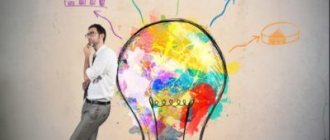Have you ever encountered stubborn people who are difficult to convince of anything? Or perhaps you yourself are not flexible and have difficulty changing your beliefs, behavior, and perceptions? Stubbornness is often considered a stupid whim, a whim, a manifestation of egocentrism, etc. But in fact, it is a manifestation of a special personality quality called rigidity. It can control our lives, but getting rid of it is not so easy, because rigidity is associated with many mental processes, and we are often predisposed to it from birth.
Types of people with rigid thinking
How to recognize rigid people? Psychologists have compiled a list of distinctive features of such individuals. Here is the psychological characteristic:
- Such people tend to be stubborn. It is difficult to convince them of anything; they will stand their ground.
- Habits are with them forever: it is unrealistic to undermine the system of their habits created over the years; they remain faithful to them.
- Such people have a high degree of impressionability; something new and unusual causes a storm of emotions in them.
- Suggestible, even too suggestible, such suggestibility is dangerous.
- They cannot correct their mistakes and are not capable of analyzing them.
Such people are attached to their stereotypes, which prevents them from perceiving new trends and knowledge. Changing themselves is a difficult step for them: becoming different, changing ideas, opinions and thoughts will be hard work. The inflexibility of thinking is explained by the assimilation of new things not through one’s own feelings and experience, but with the help of an authoritative opinion.
Rigidity is not always a bad thing: if a person has a moderate “dose” of it, it will help him in defending his priorities. If a person remains true to his life principles, is neat and pedantic, then this cannot be regarded negatively. Moderation is needed in everything, including the manifestation of rigidity.
These people love straightforwardness and specifics, otherwise they begin to lose their temper. They have better mental defense mechanisms and are resistant to stress and external stimuli.
In psychology, there are several types of people distinguished by rigid behavior:
- "Flower". This individual tries to protect himself from the group and has a minimal beneficial effect on its goals. This negatively affects the work of the entire group as a whole and causes tension among its members, and can also negatively affect the mental state of the “flower” himself.
- "Jester." Using this example, it is easy to understand how a useful personality quality, in this case humor, turns into a destructive one. People with this behavior joke without knowing the limits; they perceive even serious questions as a reason for humor. Individuals with this psychological trait are usually cynical and harsh, so it is difficult for them to integrate into the team. The members of the group, which includes the “jester,” are tense and afraid to say something that might cause ridicule.
- "Grumpy." Rigid behavior manifests itself in devaluation of the environment. The individual stops seeing positive aspects and responds to any changes in the environment with a negative reaction. Such people create problems for group members because they can kill all the enthusiasm with their complaints and negativity.
- "Terrorist Talker." Individuals with this type of rigid thinking are very sociable, however, they have their “dark” sides. They strive for power and demand constant attention to their person, thereby alienating group members.
- "Conspirator". Conspirators do not pay attention to the rest of the group during discussions. These individuals often create their own isolated associations. This behavior negatively affects the group and can lead to its disintegration.
- "Doubting Thomas". A great skeptic who does not believe in the success of the group. Such an individual is cynical and often in a gloomy mood. His rigidity extends to everything around him, unlike the Grumpy, who has a negative attitude towards one or two issues.
In psychology, rigidity of thinking is assessed as a negative character trait of a person, since it creates some problems in group or individual behavior. However, in moderation, it can be beneficial. Thus, rigidity is the key to success in such professions as accountant, assembly line worker, and dispatcher.
Ways to overcome
Correcting the behavior of people with high levels of rigidity is not an easy task. The strategy of interaction with a person of this type should be based on an implicit belief in the form of a recommendation, so that the individual himself gets the impression that the belief comes from himself, and the psychologist only confirms its correctness.
For unlearning to be successful, employees must know that unlearning initiatives depend on their own thinking and actions. Managers must put themselves in the shoes of their employees and think about how to motivate and engage them.
These are the main ways to overcome rigidity for teachers and organizational leaders:
- Isolation from previous experience.
- Situational awareness.
- Temporal and spatial freedom.
- Encouraging a culture of forgiving mistakes.
- Reducing the influence of old knowledge over time.
Here is one example of a successful way to overcome rigidity using a combination of methods:
Doppelmayr, one of the world leaders in the ropeway market, planned to develop a radically innovative product. Senior management felt it necessary to free their employees from preconceived notions, assumptions and other biases.
The idea was to refrain from using drawings and sketches for existing products and start from scratch. Starting with the core team, employees were assigned to a vacant position within the organization 1 day per week for approximately 1 year.
They were located in offices without telephones to isolate them from everyday activities. This helped the team focus on the new product. During this time, employees had the opportunity to question assumptions about existing products in a safe environment.
Employees did not have to fear negative consequences for making critical mistakes. The new product contained several radical innovations and was well received by customers.
Employees are strongly encouraged to get rid of old notes, documents or other information that may make it difficult to generate new ideas. Those interviewed confirmed that this practice really helped them gain new perspectives.
Providing employees with islands of spatial and temporal freedom allows them to question routines, habits and ingrained ways of thinking. This allows employees to unlearn previous experiences, assumptions, and procedures while making room for new ideas and behaviors.
Managers must implement and develop a culture that allows employees to make mistakes and mistakes during the innovation process. Open-minded and proactive people will especially benefit from a forgiving culture that allows for mistakes.
Only when employees are confident that they can make mistakes will they begin to think and do things differently. Of course, they may fail at first, but you can think about it in a new way: they didn't fail, they just found one way that doesn't work.
Perhaps the biggest challenge for managers is ensuring that employees don't fall back into old habits and routines. To actively discard old knowledge from the cognitive and behavioral repertoire of organizational members, managers need to remove the stimulus-response patterns that trigger the use of old knowledge
For example:
- Rearrange tables and furniture.
- Intentionally disrupt the exchange of information, disable the Internet.
- Block the use of certain incentives and procedures, or change corporate language by removing terms or phrases that were associated with the old one.
In psychology, rigidity is a factor that significantly reduces the performance of employees and students. Managers, teachers and organizers are recommended to take measures aimed at preventing and overcoming rigidity.
Author: Svitkevich Julia
Learn to deal with your initial reaction
What usually happens when plans go wrong?
The first reaction is a wave of emotions: aggression, irritation, indignation. This reaction is involuntary, instinctive.
Realize that this is just a reaction, let the emotions pass through you, balance yourself and make a conscious choice on how to act in this situation.
With experience, when you learn to be flexible, you will not react. You will not have an emotional outburst or an acute reaction to changing circumstances.
Example. Your computer has broken down and you need to work. If you can’t resolve this issue in the near future, think about why you need this situation.
On the one hand, you are left without the opportunity to work, and you have a lot to do.
On the other hand, maybe this is just an opportunity to do what you have long wanted, or simply think about your goals and, perhaps, reconsider them in a calm environment.
The main point here is this: you DO NOT fall into the victim state: “How can this be? What to do now?"
You take the necessary measures in the current situation, do everything that depends on you and switch to another task while you wait for the issue to be resolved.
Types of higher nervous activity in humans
Back in the 4th century. BC, the ancient Greek physician Hippocrates, observing the behavior of different individuals, identified 4 types of temperament.
- Sanguine – strong, seasoned, labile.
- Choleric – strong, uncontrollable, hot-tempered, easily excitable.
- Phlegmatic - strong, calm, with low lability of nervous processes, inert;
- Melancholic - weak, easily tired, with low performance.
In the modern world, the concept of the typological accessories of the nervous system of both humans and animals has become one of the key aspects of I. P. Pavlov’s teaching on higher nervous activity.
Depending on this specificity, I. P. Pavlov defines 4 types of higher nervous activity, the identification of which is based on various combinations of three leading indicators:
- forces - the intensity of the processes of excitation and inhibition;
- poise - balance or predominance of the intensity of the processes of excitation and inhibition;
- mobility - the speed of replacement of the process of excitation with inhibition and vice versa.
- The first type is “living” and coincides with the sanguine person of Hippocrates. It is characterized by increased intensity of nervous processes, their balance and extreme mobility. The transition from one conditioned reflex to another occurs quickly.
- The second - “unrestrained”, is identified with the Hippocratic choleric. It is distinguished by the intensity of nervous processes, the predominance of nervous excitation over inhibition, and their high lability.
- The third is “calm” and coincides with the phlegmatic person. It stands out for the intensity of nervous processes, their balance, and low lability. Inactive, highly excitable, slow. Reacts adequately to strong external influences and is balanced.
- The fourth is “weak”, identical to the melancholic. It manifests itself as a low intensity of nervous processes and their reduced lability. In this type, both excitation and inhibition are weakened, but inhibition is to a superior degree. The formation of conditioned reflexes is difficult, and prolonged or severe irritation causes rapid nervous exhaustion.
In the 20s of the twentieth century, guided by the idea of two signal systems that form a person’s idea of the environment, Academician I. P. Pavlov created a typology of higher nervous activity inherent exclusively to the human personality.
Based on the predominance of one or another signaling system, I. P. Pavlov identified:
- Artistic type – individuals with a dominant first signaling system. They are characterized by imaginative thinking, heightened emotional background, and developed imagination. They predominate among creative figures.
- Thinking type – individuals with a priority of the second signaling system. They are distinguished by their predominant abstract thinking, analytical mind, and ability to systematize information. These are scientists.
- The average type is the human majority, people with both equally developed signaling systems.
- Genius type - persons with extremely developed signaling systems. A very rare type.
The doctrine of the types of higher nervous activity is an important link in understanding the logic of the emergence of such psychological personality traits as temperament or character. Features of the type of higher nervous activity and temperament represent the natural core of the individual uniqueness of the individual.
Reasons for the formation of this trait
Poor mental mobility can be congenital or socially conditioned. In psychology, it is generally accepted that rigidity of thinking is caused by factors such as:
- genetic predisposition (for example, a child inheriting a phlegmatic type of temperament from parents);
- character accentuations;
- low speed of mental processes, weak reactivity of the nervous system, disturbances in the process of its functioning;
- low rate of mental activity due to biochemical changes in the brain;
- endocrine disorders;
- age-related changes in the psyche, manifested in the form of conservatism in views and habits;
- mistakes in family education, many prohibitions and punishments, increased demands on the child;
- coldness of parent-child relationships;
- unfavorable psychological situation in the family;
- intrapersonal emotional conflict;
- exposure to psychotraumatic factors, stress, depression;
- disappointment in personal life;
- lack of opportunity for self-realization;
- failures in professional activities, tense interpersonal relationships in the production team;
- neurasthenia, hysteria, neurosis, psychosis;
- autism, narcissistic personality disorder, Asperger's syndrome;
- encephalitis, meningitis;
- radiculitis, cervical spine injuries, osteochondrosis;
- Parkinson's disease, stroke, brain abscess;
- poor nutrition;
- alcohol or drug addiction;
- chemical poisoning;
- injuries and organic damage to the brain or spinal cord.
In psychology, it is believed that the foundation for the development of such a quality as rigidity is a combination of psychophysiological prerequisites with social factors.
What are the causes of rigidity?
A slight rigidity in character is inherent in almost all representatives of our species. This is a kind of natural mechanism that helps the brain work in an economical mode. Often patterns and stereotypes help maintain mental stability, especially during shocks and psychological trauma. Some people have flexible thinking, capable of changing a set of templates to a new, more perfect one, while for others this process is extremely difficult or even becomes an impossible task.
Rigidity can leave the norm for various reasons. These include genetic predisposition, mental health problems, parenting, head injuries and brain damage associated with illness or fetal development.
Experts attribute the following factors to psychophysiological reasons:
- Features of the nervous system (reactivity);
- Crises of different ages;
- Certain character traits (pedantry, perfectionism, over-punctuality).
In addition, mental rigidity manifests itself in many people who have crossed the threshold of old age. With age, this quality intensifies, and a person clings to familiar patterns of behavior. Older people tend to deny everything new, especially at the stage of getting to know it. However, this behavior is not only observed in older people. If we compare teenagers and thirty-year-old people, the former master modern technology much faster than their older brothers.
Social rigidity. It occurs for a number of reasons, which are usually combined into one group. It includes upbringing and life experience. If childhood was spent in an atmosphere of prohibitions and restrictions, imposed patterns, then rigid thinking may develop. Other factors that can trigger social rigidity:
- Psychotrauma;
- Impossibility of self-realization;
- Failures in the profession;
- Personal problems;
- Internal conflicts.
Rigidity of thinking
In the process of self-development of one of the options, we always mean independence of thinking, what is called heuristic, creative thinking, when we ignore generally accepted stereotypes, models and clichés, trying to embrace everything with our own mind and form an independent individual perception of the world, and based on this perception, model creative behavior that makes us more effective at solving problems.
However, why are stereotypes needed, why do they exist at all? Following stereotypes as ready-made models is an energy-saving technology when we spend as little as possible. For most people, the mental and energy resources do not always allow them to use creative thinking; there is simply not enough of it to carry out such costly activities. That’s why we all show rigidity in our attitudes at times.
Unconsciously, a person avoids a heuristic approach and tries to use ready-made models in life, thereby preserving resources for his life support and pressing problems that he has in life. Therefore, the problem of free thinking, creativity and openness to new experiences is not always a problem of a person’s choice, it rather has to do with psychophysiology.
Rigid thinking leads a person to other types of rigidity, including motivational and emotional rigidity. Based on the interpretation of what is happening, a person chooses goals, a certain set of roles, and gives everything a strict and unambiguous assessment.
For example, the whole life of a rigid woman can be completely reduced to the role of a mother; she has adopted the values and attitudes of her parental family and devoted her whole life to their implementation, without the critical assessment and revision that reality often requires. This woman may not see other sides of herself, but if she did this, she would see herself as a beautiful woman or businesswoman, and, of course, would be able to realize herself more fully. However, rigidity of thinking does not allow this to be done, and emotional rigidity convinces a person that happiness is found only on this once chosen and correct path. A person believes that he should be happy, but in reality this feeling is not there, and he literally does not allow himself to look at life differently.
A rigid personality is capable of achieving good, even high results in the chosen field, because he puts all his efforts only in this direction, without changing it or getting scattered. Here, rigidity is close to perfectionism, when a person spends resources disproportionate to the result to do everything perfectly. Having received the result that the rigid person so diligently strived for, he will expect recognition from others, but may remain reduced, unmanifested in many other areas. That’s why rigidity leads to a whole list of problems, including problems of self-esteem, relationships, exhaustion, overvalued ideas, and separation from reality.
A less rigid person will be able to try new things, learn from mistakes, gain experience, develop comprehensively, this will allow him to achieve results not only in his chosen area - thanks to a whole list of mastered means, but also in other areas. As a result, he will gain greater satisfaction and life experience, and will be able to express himself more fully. An extremely rigid person, observing the positive results of such not always ideal and correct actions, may experience envy and disappointment, because he did everything as he should, and it is he who deserves the approval of others for the result!
Of course, it is possible to develop flexibility of thinking, but this will require the restructuring of neural connections, which sometimes requires enormous effort and time. Having developed flexibility, a person will be able to push his boundaries, expand his personal living space and horizons, and be open and accessible to the outside world.
Allow yourself to be imperfect, reconsider your previous attitudes by asking why it should be this way. Correctness is not an indicator of high moral qualities, but only inflexibility, which does not give rise to pride and will prevent you from achieving results. Raise the deferred desires that you have long rejected, consider them as a possible resource, ask yourself what will be better when you allow yourself to do what you want. If you are able to deviate from the norm, you will appear to yourself and others as a more free, lively and natural person.
"Wittgenstein's ladder"
It sounds simple, but in reality it is very difficult to get rid of rigid thinking and you should contact a specialist who will create an individual treatment program for you.
The problem with rigidity is that no matter how much the patient wants to get rid of the desire to follow the rules, his inner “I” protests. The subconscious convinces him that by overstepping his rules, a person will turn into an unprincipled person, capable of any base act.
Patients who have overcome their rigidity say that in reality it turns out that there was no rigidity, only honor, integrity, beliefs and faith in traditions on an inflated scale.
To convince yourself to get rid of the belief in the correctness of your actions, repeat to yourself that truth is a relative concept; you may have misunderstood it when you heard or read it. Are you sure that your actions, actions and their motives are the truth? And in our impermanent world, is it possible to be sure that the truth remains and is understood in the same way as it was an hour, a day, a month ago?
Convince yourself that truth is unknowable.
Accept for yourself and come to terms with “Wittgenstein’s ladder”, which sounds like this:
Identification technique
A 75-item self-report measure of attitude flexibility is also used to measure rigidity. However, the most acceptable method is the “rigidity questionnaire” developed by American psychologists.
It specifically measures rigidity of thinking and is one part of the Behavioral Rigidity Test. It has good reliability and is acceptable. The test also gives results on a true-false scale. Lower scores indicate that the person is more rigid.
An example item: “Once I make a decision, I rarely change it.”
"Wittgenstein's ladder"
It sounds simple, but in reality it is very difficult to get rid of rigid thinking and you should contact a specialist who will create an individual treatment program for you.
The problem with rigidity is that no matter how much the patient wants to get rid of the desire to follow the rules, his inner “I” protests. The subconscious convinces him that by overstepping his rules, a person will turn into an unprincipled person, capable of any base act.
Patients who have overcome their rigidity say that in reality it turns out that there was no rigidity, only honor, integrity, beliefs and faith in traditions on an inflated scale.
To convince yourself to get rid of the belief in the correctness of your actions, repeat to yourself that truth is a relative concept; you may have misunderstood it when you heard or read it. Are you sure that your actions, actions and their motives are the truth? And in our impermanent world, is it possible to be sure that the truth remains and is understood in the same way as it was an hour, a day, a month ago?
Convince yourself that truth is unknowable.
Accept for yourself and come to terms with “Wittgenstein’s ladder”, which sounds like this:
Types of rigidity
Since rigidity affects human behavior in different areas, in psychology there are three types of it.
Affective or emotional
This type of rigidity is associated with the characteristics of the manifestation of emotions and reactions to external influences. Affective rigidity manifests itself as excessive stability and constancy of emotional states. Such people can replay the same episode of life in their heads for a very long time, experiencing all the same feelings that do not weaken over time and can become obsessive.
Rigid people also have the same emotional reactions, and in similar situations they behave the same way. But such people are monogamous and do not change their affection, even if its object no longer reciprocates their feelings.
Motivational rigidity
This is perhaps the most noticeable type of this personal quality. It is the people who possess it who are usually called stubborn. They can be divided into 3 types:
- Disappointed are those who, having failed once, give up, consider themselves losers all their lives and do not want to make efforts to change the situation in their favor.
- Stubborn are those who persistently “break into the wall”, not wanting to notice that there is an entrance nearby. They are not able to deviate from a pre-chosen path, change ineffective methods of activity, and they also cannot abandon a goal once set.
- Lazy people are those who, from childhood, have convinced themselves that career and success are not for them. In the complete absence of positive motivation, they do not seek it. Since they won’t succeed anyway, why waste energy and try. These people quietly go with the flow and consider any changes a disaster.
People whose level of rigidity is normal are able to manage their motivational sphere and, when some motives are lost, actively seek others.
Cognitive rigidity
This is inflexibility, rigidity of thinking and perception. It is characterized by a person’s lack of need, and often the ability, to change his thinking style, his views on the world, his beliefs and ideas, even if they are unproductive and obviously incorrect.
Rigid people think in standard patterns and are not at all inclined to creativity. Cognitive rigidity prevents you not only from solving non-standard problems, but also from acquiring new knowledge, because it does not fit into once created patterns and schemes. Therefore, everything new, original, unconventional is rejected and recognized as incorrect, unnecessary and dangerous.
Operating principle of cogeneration plants
Depending on the principle of operation, there are several types of cogeneration stations. Let's consider cogenerators based on gas piston units. Combustible gas of the required parameters is supplied to the gas piston engine. During the combustion of fuel, mechanical energy is generated, transmitted through a single shaft to the generator and converted into electrical energy of standard quality parameters.
When an internal combustion engine operates, a large amount of heat is released, which can be recovered using special equipment and then used. At the same time, no additional amount of fuel is consumed to obtain this energy - this product is a by-product in the technological process of generating electrical energy. The main sources of associated heat during the operation of a gas piston power plant:
- heat of cooling water (“jacket” of engine cooling);
- waste heat (exhaust gases).
These sources can be used to obtain thermal energy (heat recovery), thereby regulating the temperature and volume of energy resource production, as well as the volume of installed auxiliary equipment.
The heat recovery system from cogeneration plants makes it possible to obtain associated thermal energy of the required parameters using heat exchangers and waste heat boilers, which remove heat from heated parts and environments. The generated thermal energy is supplied to the existing heat supply system of the enterprise (cogeneration). If associated heat is not used, thermal energy is discharged into the atmosphere.
A schematic diagram of the technological process of heat recovery from gas piston units is shown in the figure below.
Schematic diagram of the cogeneration installation device
The thermal (thermal) efficiency of the GPU is approximately on the same level as the electrical one, providing almost the same output parameters for electrical and thermal power, regardless of whether a cogeneration plant of low, medium or large power is considered.
The operation of the heat recovery system of a gas piston unit is organized by several thermal circuits. An enlarged diagram of the technological process of operation of GPU circuits with a nominal electrical power of 2000 kW to ensure heat recovery from heat exchangers and waste heat boilers is shown in the figure below.
Technological thermal diagram of the cogeneration station MWM 2000 kWThe given process diagram shows exclusively the hydraulic connection of the MWM gas piston unit.
The following contours are indicated in the figure:
- engine cooling circuit;
- mixture cooling circuit;
- heating circuit;
- emergency cooling circuit (system).
The water temperature at the outlet of the heat recovery system of the cogeneration plant is 90°C; at the inlet, the water arrives at a temperature of 70°C. 50% of the heat is obtained by cooling the engine using ethylene glycol/water heat exchangers, while the coolant is heated by 10°C (from 70°C to 80°C). The remaining 50% of the heat is produced by cooling the exhaust flue gases from 500°C to 120°C in the recovery boiler. At the same time, the coolant heats up by another 10°C (from 80°C to 90°C).
When operating a gas piston power plant, generating electrical energy is a priority. The production of thermal energy (heat cogeneration) is proportional to the degree of load of the machine (the amount of electricity generated). Russian-made cogeneration plants are less common on the small-scale distributed energy market, but have a similar operating principle and conditions.
How does rigidity manifest itself?
After considering the theory, it becomes interesting who is characterized by rigidity in everyday life. Maybe such people surround us, but we have no idea about their characteristics? As a rule, this is true. After all, this property most often manifests itself only partially, turning people into stubbornness only in one aspect of life. A total of six psychotypes endowed with this trait were identified.
1. A sociable person who loves to talk. Personalities of this type have well-developed speech, a rich vocabulary and the ability to communicate. At the same time, they are distinguished by their callousness and “deafness” in relation to other points of view. They say about such people: “there are only two opinions - mine and the wrong one.” They do not intend to change anything in their behavior, since the primary task is to express their own point of view and demonstrate their abilities.
2. A pessimist who is dissatisfied with life. This person is fixated on the negative; every mistake or failure is experienced for a long time and painfully. Any positive thoughts and feelings are practically inaccessible to him, and new opportunities pass by unnoticed by him. He enthusiastically complains about his problems, categorically ignoring the feelings of other people.
3. Distrustful and categorical. He is distinguished by cynicism and straightforwardness. Gets satisfaction from “speaking the truth.” He considers himself straightforward and truthful, but in reality he is a callous person who does not know how to sympathize with others. Not prone to empathy. This rigid behavior is typical of a leader.
4. Greenhouse plant. Prefers solitude and does not delve into what is happening. He is betrayed by arrogant behavior, wariness and reluctance to communicate. Believes that other people are capable of bringing chaos into his measured way of thinking and communication with them promises nothing but trouble.
5. A demonstrative joker and a merry fellow. He perceives everything that happens around him and in the world through the prism of skepticism and fatalism. He is distinguished by irony and cynicism, prefers black humor. Strives to be the center of attention, but with his behavior he pushes away and deeply hurts people without noticing it.
6. Gray cardinal. This rigid person is one who looks down on others, prefers to surround himself with selected confidants, and is prone to intrigue. Rigid behavior is expressed in isolation and the desire to hide one’s feelings, while happy to discuss other people’s secrets. He prefers not to pay attention to the consequences of his behavior.
Signs of rigidity can be observed among work colleagues, relatives and political figures:
Inability and unwillingness to change the chosen line of behavior, regardless of the need; Stubbornness and blind persistence in defending one’s own point of view; Obsession with an obsessive idea even contrary to common sense; The need to perform daily rituals, or in connection with recurring situations; A predetermined pattern of behavior that a person diligently follows, a trained sequence of actions; The desire to insist on one’s own and the desire to leave the last word in the dispute only to oneself; Tendency to dominate any conversation, inattention to interlocutors; Lack of flexibility of behavior in critical, stressful situations.
The listed signs may occur partially, and the presence of one does not interfere with the manifestation of other excellent personality traits. Difficulties with communication arise when a person has several points at once. The more areas rigidity affects, the more difficult the interaction with its owner.
Rigid mentality is quite common, and this trait can manifest itself in many people. In small doses, it is even useful, as it helps maintain internal balance and increases stress resistance. However, to a large extent, rigidity interferes with normal life and communication. To overcome the problem, you need to consult a psychologist. Specialists conduct systematic sessions with clients aimed at enhancing flexibility and plasticity of perception.
Why is rigidity bad and how to get rid of it?
Indeed, what’s wrong with stubbornly overcoming all obstacles, going towards a goal, defending your beliefs, or being faithful to your lover all your life? Not bad, of course. But unfortunately, rigidity is not limited to this and, like any personal qualities, it has its negative sides, especially when dealing with its high level. And perseverance turns into obstinacy, defense of one’s beliefs into fanaticism, and loyalty to one’s beloved into the desire to keep her close to you even against her wishes.
It turns out that rigidity often does not help a person in life, but hinders him:
- prevents the assimilation of new things, and, therefore, reduces the effectiveness of training and development;
- prevents a person from adapting to a rapidly changing world;
- is a source of interpersonal conflicts when stubbornness makes a person irreconcilable and incapable of compromise;
- can provoke a life-threatening situation when an overly confident person ignores the danger;
- often supports the passivity and inertia of people prone to laziness;
- Constantly experiencing and “chewing” emotions leads to emotional burnout, frustration and neuroses.
As you can see, there is a lot of harm from rigidity. And even if a person himself feels that his own stubbornness and conservatism are preventing him from developing and achieving success, then, undoubtedly, measures should be taken. In order to make your behavior more flexible and flexible, it is better to consult a psychologist or psychotherapist. (And if we are talking about pathology, then see a psychiatrist). Psychotherapy, psychoanalysis, psychocorrectional measures and communication trainings quite effectively remove the negative manifestations of rigidity.
But if rigidity manifests itself only as an insignificant background in a person’s behavior, then it can simply be taken into account when choosing a field of activity or social circle. A person’s awareness of his behavioral problems is already the path to their resolution.
Rigidity - what is it?
The term “rigidity” translated from Latin means inflexibility. In Russian, this definition is not always used for its intended purpose, confusing it with others with similar properties. In America, it is used exclusively in psychology and neurology. Rigidity is a person’s inability to adequately respond to changing circumstances.
Rigid people are often called stubborn, incapable of leaving their comfort zone, and zealously defending their positions in life. At the same time, defending your habits can take place not only in dialogue with your interlocutor, but also in various life situations, even contrary to common sense. People who have such a pronounced character trait as rigidity are pedantic, with high self-esteem, overly straightforward, stubbornly defending their own interests.
For your information. In fact, rigidity of thinking is present to one degree or another in every person. In some it is expressed moderately, in others this trait has a leading function in character.
A person with a moderately rigid character type has a flexible mind, he is inventive, rational, but is completely unable to adapt to different life situations. He is very punctual, precise in expressing thoughts, specific in requests and judgments. Rigid people are enraged by amorphous people, irresponsible, sloppy, who cannot clearly plan not only their immediate future, but even the coming day.
Rigidity is a sign of stress resistance in psychology, due primarily to the fact that people with this type of character are less subject to public opinion. They don’t care how their neighbors, friends or strangers live, the main thing is that nothing affects their sense of personal comfort. In some cases, they are able to begin to impose their opinion.
Main causes
Rigidity in psychology is a personality trait that, accordingly, develops at the appropriate stages of development. Children are the most vulnerable. Especially if this is accompanied by psychophysiological or social factors.
Psychophysiological reasons
A psychophysiological risk factor for the development of rigidity is the type of person’s temperament. Thus, flexibility of thinking is characteristic of individual style, and as the main carrier of the style characteristics of temperament, therefore, flexibility should be determined by temperament.
Flexibility or rigidity of thinking is based on the mobility of the nervous system. The mobility of the nervous system is the speed of the subject’s reaction to changes in sign stimuli, adaptation, the ability to change one’s behavior in accordance with changes in the influencing stimuli.
The works of V. M. Rusalov show the relationship between the basic properties of the nervous system, temperament and rigidity or flexibility of thinking. Rusalov conducted an experimental study of the relationship between the properties of temperament and the characteristics of creativity according to the P. Torrance test. He came to the conclusion that creativity is determined by temperament.
For example, temperaments with a less mobile nervous system are susceptible to rigidity: melancholics, phlegmatics.
Social reasons
Rigidity of personality is usually acquired as a quality between the ages of 3 and 5, when the child identifies himself with a parent of the same sex.
Rigidity in psychology
For a child of this age, the reaction of a parent of the same sex to his actions and self-expression is extremely important. If a child receives a lot of comments and criticism, he decides that he is being treated unfairly and also decides to become more perfect. To protect his pain, he puts on a cold, hard mask, which creates the impression that the person does not know how to feel and is not capable of warm relationships.
This feature becomes a characteristic feature of the rigid, although inside he is a rather sensitive person. In appearance and physique, this is manifested in maximum proportionality, balance, his body is symmetrical and has some roundness. However, inflexibility is noticeable, the arms are often crossed at the level of the solar plexus, which is a protective mechanism that allows the rigid to move away from others, not to accept emotions from them, not to feel.
Types of rigid behavior
There are several types of behavior of rigid personalities:
Individuals who are called “terrorist talkers”
Such people have increased talkativeness, but the disadvantage of this is that they try to grab attention and become the only center of any conversation.
There are those among us who are always dissatisfied with everything, they don’t like anything and it is impossible to please them in anything. People who are called "Doubting Thomas". All their rigidity is aimed at individual situations and thoughts. People are “flowers”. Such a person gradually separates from society, ceasing to make his contribution. People are “clowns”. The sarcasm and irony of these individuals know no bounds or sense of proportion. Their style is to ridicule absolutely everything in the world. People are “conspirators”. They “split” the team into separate groups, which begin to conflict over time, which leads to a gradual breakup of the team.
Today in psychology there are several types of rigidity, which include:
- cognitive;
- affective;
- emotional;
- motivational.
Let's look at each of the varieties for a more detailed understanding of this phenomenon.
Cognitive
Cognitive rigidity is the difficulty in restructuring perception from one question to another, from changing one topic to another, and from completely changing one picture of the world to another. Many subjects live in their own exclusive reality, categorically refusing to create a new picture of the world, even if it is required by certain conditions and new information that displaces the old one. People with cognitive rigidity will act in certain situations and solve certain problems only according to their old and proven patterns.
Affective
Affective rigidity presupposes the presence of certain responses in the human consciousness. This variety implies the affectivity of certain responses to changing emotional objects.
Emotional
Emotional rigidity implies difficulty in restructuring the system of motives in certain life circumstances. At the same time, circumstances require restructuring, plasticity and behavior change.
Many scientists argue that emotional rigidity is a kind of “stable emotion” to everything, an unchanging reaction. It turns out that despite the regular change of circumstances or situations, the individual continues to react to them in the same way, without changing his emotions. That is, no matter what happens, there will be no change in the emotional state.
Motivational
Motivational rigidity is a type that involves stagnation of a person in his own reality and a complete reluctance to change monotony. That is, a person categorically refuses to burden himself with this kind of tasks in order to adapt to the new world and information. This also includes the fact that the individual does not want to change the usual ways of satisfying his needs, completely “trusting” the old ones.
Risk factors
Psychological rigidity is especially noticeable in populations with anxiety disorders. For example, people who struggle with flexible thoughts, emotions, and behaviors are at increased risk of developing major depressive disorder.
Routine is another contributing factor to failure to unlearn. Due to the daily routine, employees rarely have enough time to identify outdated practices. Thus, people with responsible jobs are at risk.
In addition, people are exposed to more and more information, which can lead to sensory overload. Excessive amounts of meetings, phone and video calls, email, and exposure to the Internet, social media, and news can lead to an inability to separate relevant knowledge from irrelevant knowledge.
Resistance to not learning also arises from people's fear that taking risks will lead to critical mistakes. Due to the fear of making a critical mistake, employees tend to refrain from trying new ways of doing things but prefer to stay on the safe side.
Disadvantages of Rigidity
But rigidity has many more disadvantages. With pronounced rigidity, the person becomes narcissistic and very conflicted, and passion for some activity or hobby is put at the forefront of activities, overshadowing everything else. Most often, these signs appear in patients with mental illness.
In a situation where rigidity is expressed to an extreme degree, the person, on the contrary, is observed to be careless and irresponsible. Excessive activity alienates others, and most do not understand the ardent desire to achieve a goal.
Increased rigidity is most often accompanied by emotional instability and paranoia. Individuals are susceptible to obsessions, sometimes overly aggressive and unable to establish contact with the outside world.
In life, mental rigidity prevents a person from being simply happy, since he often does not allow himself small pleasures, considering short-term desires a waste of time and effort.
Manifestations in humans
More pronounced rigidity in psychology is characteristic of psychopaths with signs of paranoia. Such individuals, as a rule, are characterized by conflict and affective capture by the dominant idea. Often a typical example of rigidity is the introverted personality type.
The introverted type is characterized by low contact, isolation, isolation from reality, and a tendency to philosophize. Such people love solitude; They come into conflict with others only when they attempt to unceremoniously interfere in their personal lives.
They are often emotionally cold idealists with relatively little attachment to people. They have such attractive traits as restraint, strong convictions, and integrity.
Rigidity in psychology is stubbornness, persistent defense of one’s ideas. Such people have their own point of view on everything, which may turn out to be erroneous, differ sharply from the opinions of other people, and yet they continue to defend it, no matter what.
Thus, the following traits indicate rigidity. This can be both external behavior and personal qualities.
For example:
- Persistently repeated behavior.
- Difficulties with unmet expectations.
- Perfectionism.
- Compulsions (rituals, repetitive actions).
- Persistence.
- Associated internalizing behaviors.
- Obsessions (as in OCD).










